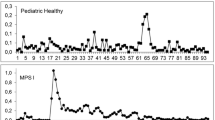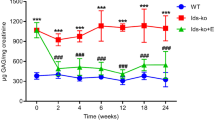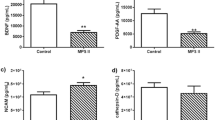Abstract
Background
Sanfilippo disease (Mucopolysaccharidosis III) is a neurodegenerative lysosomal disorder characterized by accumulation of the glycosaminoglycan heparan sulfate (HS). MPS III has a large phenotypic variability and early assessment of disease severity is difficult. We investigated the correlation between disease severity and the plasma concentration of HS (pHS, defined by the sum of the heparan sulfate derived disaccharides obtained after enzymatic digestion) and urinary total GAGs level (uGAGs, measured by the dimethylene blue test) in a cross-sectional cohort of 44 MPS III patients.
Methods
Disease severity was established on the basis of the age of complete loss of independent walking and of full loss of speech in all patients. Hazard ratios (HR) were obtained with cox-regression analysis. In order to allow prediction of a severe phenotype based on a cut-off value for pHS, patients were divided in two groups (severely affected and less severely affected) based on predictive mutations or on the age of full loss of speech. Receiver operator characteristics (ROC) were obtained for pHS.
Results
pHS and uGAGs were independently and linearly associated with an increased risk of speech loss with a HR of 1.8 (95 % CI 1.3–2.7) per 500 ng/ml increase of HS in plasma (p = 0.002), and a HR of 2.7 (95 % CI 1.6–4.4) per 10 mg/mmol creatinine increase of uGAGs (p < 0.001). pHS and uGAGS were less strongly associated with loss of walking. The area under the ROC curve for pHS was 0.85, indicating good discrimination.
Conclusion
pHS and uGAGs may be useful biomarkers for prediction of severity in MPS III.




Similar content being viewed by others
References
Baehner F, Schmiedeskamp C, Krummenauer F et al (2005) Cumulative incidence rates of the mucopolysaccharidoses in Germany. J Inherit Metab Dis 28:1011–1017
Ben Turkia H, Tebib N, Azzouz H et al (2009) Incidence of mucopolysaccharidoses in Tunisia. Tunis Med 87:782–785
Cengiz N, Baskin E, Anarat R et al (2005) Glycosaminoglycans in childhood urinary tract infections. Pediatr Nephrol 20:937–939
Clarke LA, Hemmelgarn H, Colobong K et al (2012) Longitudinal observations of serum heparin cofactor II-thrombin complex in treated Mucopolysaccharidosis I and II patients. J Inherit Metab Dis 35:355–362
de Jong JG, Wevers RA, Laarakkers C, Poorthuis BJ (1989) Dimethylmethylene blue-based spectrophotometry of glycosaminoglycans in untreated urine: a rapid screening procedure for mucopolysaccharidoses. Clin Chem 35:1472–1477
de Jong JG, Wevers RA, Liebrand-van SR (1992) Measuring urinary glycosaminoglycans in the presence of protein: an improved screening procedure for mucopolysaccharidoses based on dimethylmethylene blue. Clin Chem 38:803–807
de Ruijter J, Valstar MJ, Narajczyk M et al (2012) Genistein in Sanfilippo disease: a randomized controlled crossover trial. Ann Neurol 71:110–120
Delgadillo V, O’Callaghan MM, Artuch R, Montero R, Pineda M (2011) Genistein supplementation in patients affected by Sanfilippo disease. J Inherit Metab Dis 34:1039–1044
Di Natale P, Di Domenico C, Di Napoli D (2010) Serum MIP-1 alpha level: a biomarker for the follow-up of lentiviral therapy in mucopolysaccharidosis IIIB mice. J Inherit Metab Dis 33:159–165
Ellinwood NM, Ausseil J, Desmaris N et al (2011) Safe, efficient, and reproducible gene therapy of the brain in the dog models of Sanfilippo and Hurler syndromes. Mol Ther 19:251–259
Erickson RP, Sandman R, Epstein CJ (1975) Lack of relationship between blood and urine levels of glycosaminoglycans and lysomal enzymes. Biochem Med 12:331–339
Fedele AO, Hopwood JJ (2010) Functional analysis of the HGSNAT gene in patients with mucopolysaccharidosis IIIC (Sanfilippo C Syndrome). Hum Mutat 31:E1574–E1586
Feldhammer M, Durand S, Mrazova L et al (2009) Sanfilippo syndrome type C: mutation spectrum in the heparan sulfate acetyl-CoA: alpha-glucosaminide N-acetyltransferase (HGSNAT) gene. Hum Mutat 30:918–925
Glamuzina E, Fettes E, Bainbridge K et al (2011) Treatment of mucopolysaccharidosis type II (Hunter syndrome) with idursulfase: the relevance of clinical trial end points. J Inherit Metab Dis 34:749–754
Harmatz P, Giugliani R, Schwartz I et al (2006) Enzyme replacement therapy for mucopolysaccharidosis VI: a phase 3, randomized, double-blind, placebo-controlled, multinational study of recombinant human N-acetylgalactosamine 4-sulfatase (recombinant human arylsulfatase B or rhASB) and follow-on, open-label extension study. J Pediatr 148:533–539
Hendriksz CJ, Giugliani R, Harmatz P et al (2011) Design, baseline characteristics, and early findings of the MPS VI (mucopolysaccharidosis VI) Clinical Surveillance Program (CSP). J Inherit Metab Dis. doi:10.1007/s10545-011-9410-9
Heron B, Mikaeloff Y, Froissart R et al (2011) Incidence and natural history of mucopolysaccharidosis type III in France and comparison with United Kingdom and Greece. Am J Med Genet A 155A:58–68
Hopwood J (2007) Sanfilippo Syndrome: Clinical genetic diagnosis and therapies. Chapter 26. In J. Barranger, Lysosomal Storage Disorders. Springer, Berlin, 415–432
Kaplan D, Meyer K (1962) The fate of injected mucopolysac-charides. J Clin Invest 41:743–749
Langford-Smith KJ, Mercer J, Petty J et al (2011) Heparin cofactor II-thrombin complex and dermatan sulphate:chondroitin sulphate ratio are biomarkers of short- and long-term treatment effects in mucopolysaccharide diseases. J Inherit Metab Dis 34:499–508
Malinová V, Wegrzyn G, Narajczyk M (2012) The Use of Elevated Doses of Genistein-Rich Soy Extract in the Gene Expression-Targeted Isoflavone Therapy for Sanfilippo Disease Patients. J Inherit Metab Dis 5:21–25
Meikle PJ, Hopwood JJ, Clague AE, Carey WF (1999) Prevalence of lysosomal storage disorders. JAMA 281:249–254
Muenzer J, Gucsavas-Calikoglu M, McCandless SE, Schuetz TJ, Kimura A (2007) A phase I/II clinical trial of enzyme replacement therapy in mucopolysaccharidosis II (Hunter syndrome). Mol Genet Metab 90:329–337
Muschol N, Pohl S, Meyer A, Gal A, Ullrich K, Braulke T (2011) Residual activity and proteasomal degradation of p.Ser298Pro sulfamidase identified in patients with a mild clinical phenotype of Sanfilippo A syndrome. Am J Med Genet A 155A:1634–1639
Narajczyk M, Tylki-Szymanska A, Wegrzyn G (2012) Changes in hair morphology as a biomarker in gene expression-targeted isoflavone therapy for Sanfilippo disease. Gene 504:292–295
Ohmi K, Kudo LC, Ryazantsev S, Zhao HZ, Karsten SL, Neufeld EF (2009) Sanfilippo syndrome type B, a lysosomal storage disease, is also a tauopathy. Proc Natl Acad Sci U S A 106:8332–8337
Perkins KJ, Muller V, Weber B, Hopwood JJ (2001) Prediction of Sanfilippo phenotype severity from immunoquantification of heparan-N-sulfamidase in cultured fibroblasts from mucopolysaccharidosis type IIIA patients. Mol Genet Metab 73:306–312
Pinto R, Caseiro C, Lemos M et al (2004) Prevalence of lysosomal storage diseases in Portugal. Eur J Hum Genet 12:87–92
Piotrowska E, Jakobkiewicz-Banecka J, Tylki-Szymanska A et al (2008) Genistin-rich soy isoflavone extract in substrate reduction therapy for sanfilippo syndrome: an open-label, pilot study in 10 pediatric patients. Curr Ther Res Clin Exp 69:166–179
Poorthuis BJ, Wevers RA, Kleijer WJ et al (1999) The frequency of lysosomal storage diseases in The Netherlands. Hum Genet 105:151–156
Poupetova H, Ledvinova J, Berna L, Dvorakova L, Kozich V, Elleder M (2010) The birth prevalence of lysosomal storage disorders in the Czech Republic: comparison with data in different populations. J Inherit Metab Dis 33:387–396
Ruijter GJ, Valstar MJ, van de Kamp JM et al (2008) Clinical and genetic spectrum of Sanfilippo type C (MPS IIIC) disease in The Netherlands. Mol Genet Metab 93:104–111
Valstar MJ, Bertoli-Avella AM, Wessels MW et al (2010a) Mucopolysaccharidosis type IIID: 12 new patients and 15 novel mutations. Hum Mutat 31:E1348–E1360
Valstar MJ, Bruggenwirth HT, Olmer R et al (2010b) Mucopolysaccharidosis type IIIB may predominantly present with an attenuated clinical phenotype. J Inherit Metab Dis 33:759–767
Valstar MJ, Neijs S, Bruggenwirth HT et al (2010c) Mucopolysaccharidosis type IIIA: clinical spectrum and genotype-phenotype correlations. Ann Neurol 68:876–887
van de Kamp JJ, von Niermeijer MFFK, Giesberts MA (1981) Genetic heterogeneity and clinical variability in the Sanfilippo syndrome (types A, B, and C). Clin Genet 20:152–160
Weber B, Guo XH, Kleijer WJ, van de Kamp JJ, Poorthuis BJ, Hopwood JJ (1999) Sanfilippo type B syndrome (mucopolysaccharidosis III B): allelic heterogeneity corresponds to the wide spectrum of clinical phenotypes. Eur J Hum Genet 7:34–44
Wegrzyn A (2012) Gene expression-targeted isoflavone therapy. IUBMB Life 64:307–315
Wraith JE (2005) The first 5 years of clinical experience with laronidase enzyme replacement therapy for mucopolysaccharidosis I. Expert Opin Pharmacother 6:489–506
Wraith JE, Clarke LA, Beck M et al (2004) Enzyme replacement therapy for mucopolysaccharidosis I: a randomized, double-blinded, placebo-controlled, multinational study of recombinant human alpha-L-iduronidase (laronidase). J Pediatr 144:581–588
Yogalingam G, Hopwood JJ (2001) Molecular genetics of mucopolysaccharidosis type IIIA and IIIB: Diagnostic, clinical, and biological implications. Hum Mutat 18:264–281
Conflict of interest
None.
Author information
Authors and Affiliations
Corresponding author
Additional information
Communicated by: Ed Wraith
Rights and permissions
About this article
Cite this article
de Ruijter, J., IJlst, L., Kulik, W. et al. Heparan sulfate derived disaccharides in plasma and total urinary excretion of glycosaminoglycans correlate with disease severity in Sanfilippo disease. J Inherit Metab Dis 36, 271–279 (2013). https://doi.org/10.1007/s10545-012-9535-5
Received:
Revised:
Accepted:
Published:
Issue Date:
DOI: https://doi.org/10.1007/s10545-012-9535-5




